6 Types of venomous snakes in the Western Cape
Snake bites
There are 41 different types of snakes in the Western Cape. 18 Species are not venomous while 8 can inflict painful bites. 6 Species are considered potentially deadly. Snakes play an important role in our ecosystem by controlling rodent and other pests. It's important to remember that snakes are shy animals and tend to avoid people. They only strike people when threatened or when hurt.
The 6 venomous snakes found in the Western Cape are the Cape cobra, puff adder, berg adder, boomslang, rinkhals, and black spitting cobra.
Venomous snakes are dangerous and you need to be on the lookout for them, especially when hiking. Before visiting a recreational area, or going on a hiking trip, you should:
- find out if the area that you will be visiting has a medical facility nearby,
- wear leather hiking boots,
- wear long pants.
In the event of a snakebite, get a good description of the snake and take a photograph if possible. While it's not essential to identify a snake after a snakebite, such information could be of use to medical doctors. Seek medical help immediately. If you're alone, keep calm and seek help or phone for help. Don't walk too fast or run as this may speed up the distribution of venom in your body.
Types of venomous snakes found in the Western Cape:
Cape cobra
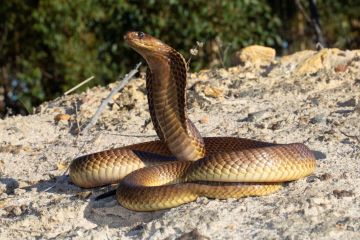 Photo: Johan Marais, African Snakebite Institute |
| Photo: Johan Marais, African Snakebite Institute |
If someone has been bitten by a Cape cobra (which has a neurotoxic venom that causes progressive weakness and may affect breathing) get the victim to a medical facility as soon as possible. It you have a Smart bandage you can apply pressure immoblisation (Smart bandages are stretch bandages with printed rectangles. The entire limb is wrapped tightly from the site of the bite towards the heart – stretch the bandage until the rectangles form squares). If the patient stops breathing, resort to mouth-to-mouth resuscitation.
The Cape cobra is common throughout the Western Cape. It is active during the day and hides in holes in the ground and under large objects. This snake is often encountered and is quick to escape if given the opportunity. If cornered it will lift its head off the ground, spread a hood and bite readily. This snake may slither into homes to escape the heat.
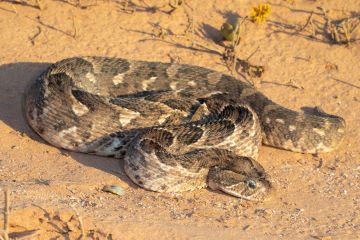 Photo: Johan Marais, African Snakebite Institute |
| Photo: Johan Marais, African Snakebite Institute |
Puff adder
This thick-set slow-moving snake is easily identified by its dark brown or blackish v-patterns on the back. Its venom is cytotoxic and bites can lead to extensive swelling, extreme pain and tissue damage. The venom is slow-acting and fatal bites are extremely rare. It is found throughout most of Africa and part of Arabia and is common and abundant in the Western Cape. The Puff Adder inhabits grasslands, savannah and fynbos.
As the venom of this snake is cytotoxic and slow-acting, there is very little that first-aiders can do. Reassure the patient and elevate the affected limb just above the heart for pain relief. Transport the patient to the nearest medical facility.
Berg adder
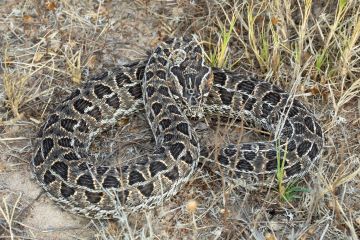 Photo: Johan Marais, African Snakebite Institute |
| Photo: Johan Marais, African Snakebite Institute |
Also known as the Cape Mountain Adder is often mistaken for the Puff Adder. Usually measuring between 30 - 40cm, this small snake is identified by its keeled scales, triangular head and dark halfmoon blotches down the back. It is usually found in mountainous regions and at sea level, such as the Cape coast, where they lie in thick fynbos or are found basking on foot paths.
The venom of the Berg Adder differs from that of most other adders in that it is mainly neurotoxic with a specific action on the optic and facial nerves, causing drooping eyelids, double vision, dizziness and temporary loss of taste and smell. While no confirmed deaths have been reported, recent studies show that most victims have breathing problems 4 – 7 hours after a bite and need to be ventilated in a hospital.
Boomslang
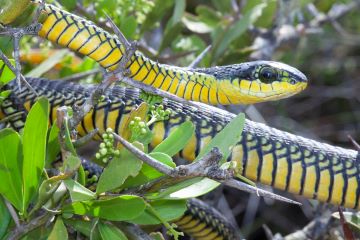 Photo: Johan Marais, African Snakebite Institute |
| Photo: Johan Marais, African Snakebite Institute |
The Boomslang is one of the most venomous snakes in the world, but because it is extremely shy and docile, bites are uncommon. It can be identified by the egg-shaped head, keeled body scales and large eyes. This snake seldom grows larger than 1.5m in length. It is found throughout much of South Africa and inhabits trees and bushes.
The venom of the Boomslang is potently haemotoxic and affects the blood clotting mechanism. It is a slow-acting venom with the first symptoms showing after anything from 5 – 30 hours – usually a bit of bleeding from the fang punctures followed by a nosebleed, bleeding from the mucous membranes and eventually massive internal breeding. There is no first aid and victims need to be hospitalised.
Rinkhals
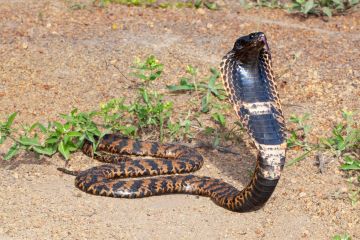 Photo: Johan Marais, African Snakebite Institute |
| Photo: Johan Marais, African Snakebite Institute |
The Rinkhals is similar to a cobra but is not a true cobra – it has keeled body scales (cobras have smooth scales) and gives birth to live young (cobras lay eggs). It seldom grows larger than 1.2m in length and tends to be a dark-grey or brownish colour with lighter bands. It is well known for playing dead – something that is seen in a number of other snakes including the Cape cobra. This snake is quick to escape and will lift its head off the ground to form a hood when threatened.
It can spit venom as far as 2.5m and aims at the eyes. The venom of the Rinkhals is largely cytotoxic and although it is considered to be one of our dangerous snakes, the last fatality was more than 40 years ago. Venom in the eyes is painful and should be rinsed with water whereafter a doctor needs to be consulted for further treatment.
Black spitting cobra
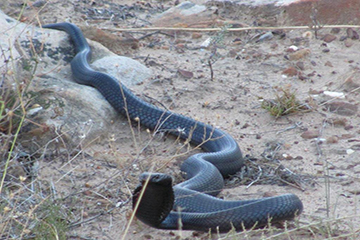 Photo: Henry Davids, CapeNature |
| Photo: Henry Davids, CapeNature |
The Black Spitting Cobra can be found east of Cape Town northwards into much of Namaqualand and north into southern Namibia and as far east as Upington.
The snake thrives in dry and arid conditions. It is most active during the day and favours dry riverbeds or rocky areas. It is a shy and elusive snake that's quick to escape if encountered. Bites are virtually unheard of.
Its venom, like that of all spitting cobras, is potently cytotoxic, causing severe pain, swelling, and tissue damage. It can also spit its venom and does so effectively. It feeds on smaller snakes, lizards, and frogs.
It's important to remember that snakes will avoid contact with humans at all costs and only attack people if they feel threatened. Stick to well trodden paths and be observant. If you see a snake wait for it to move out of the path and avoid getting close to inspect it, especially if you aren't familiar with types of snakes. Delibrately getting close to a snake puts you and those around you at risk. If you find a snake on your property, we suggest that you contact CapeNature, and they’ll put you in contact with a snake handler. You can also download the free African Snakebite Institute app, which lists over 700 snake removers throughout South Africa and includes advice on first aid for snakebite.
- What causes food poisoning?
- Common poisonous plants
- Types of spiders you should look out for
- 6 Types of venomous snakes in the Western Cape
- What to do when you're around bees
- What to do with bluebottle and scorpion stings


